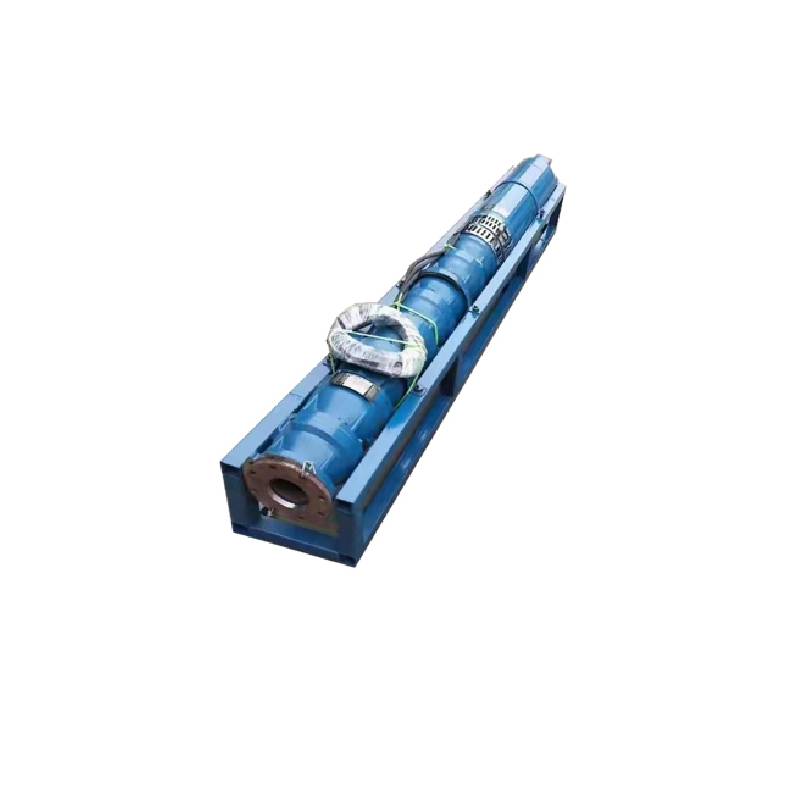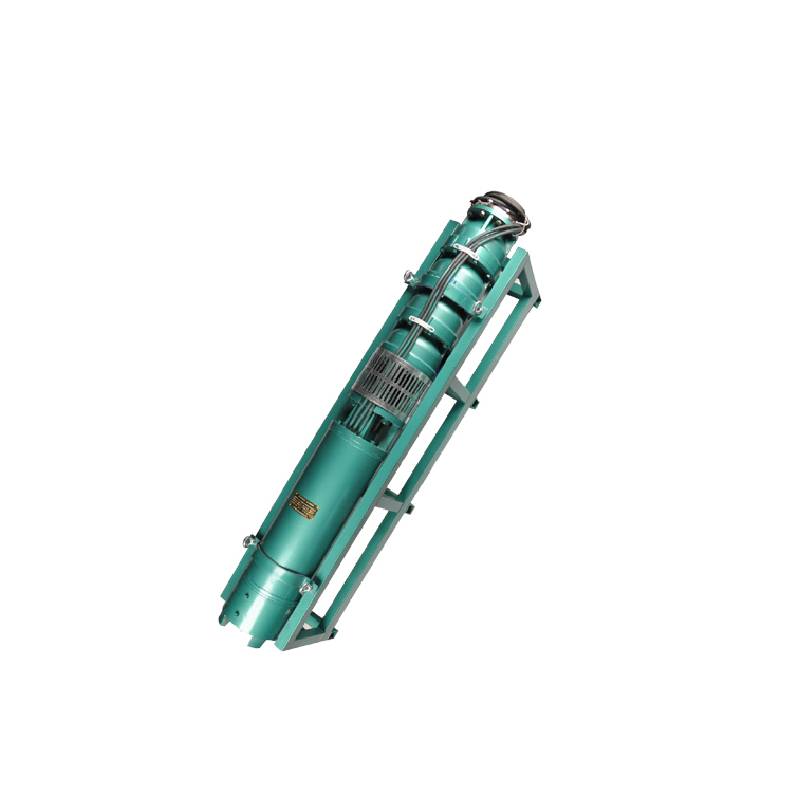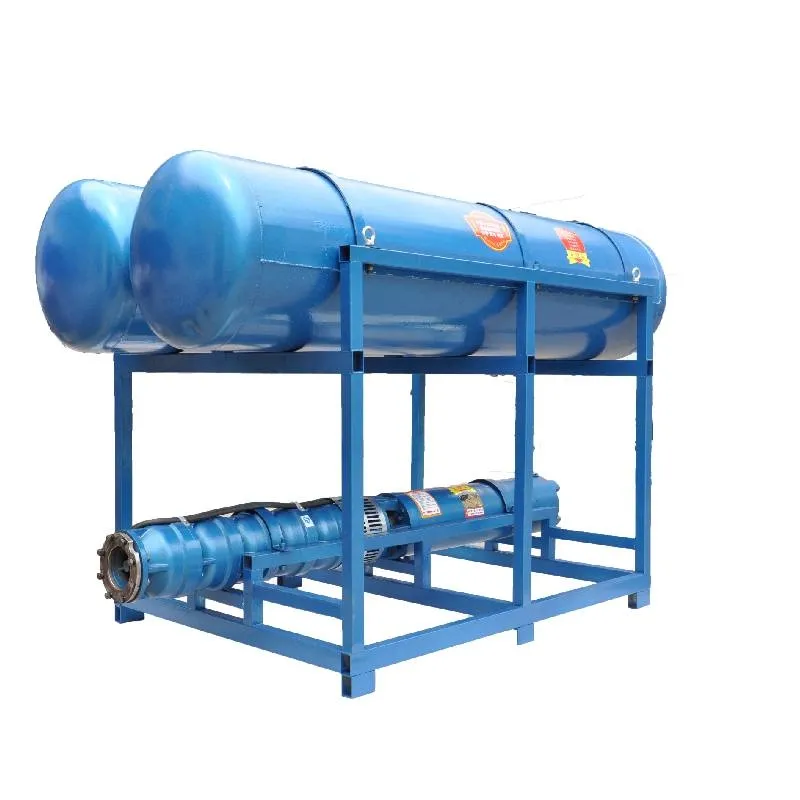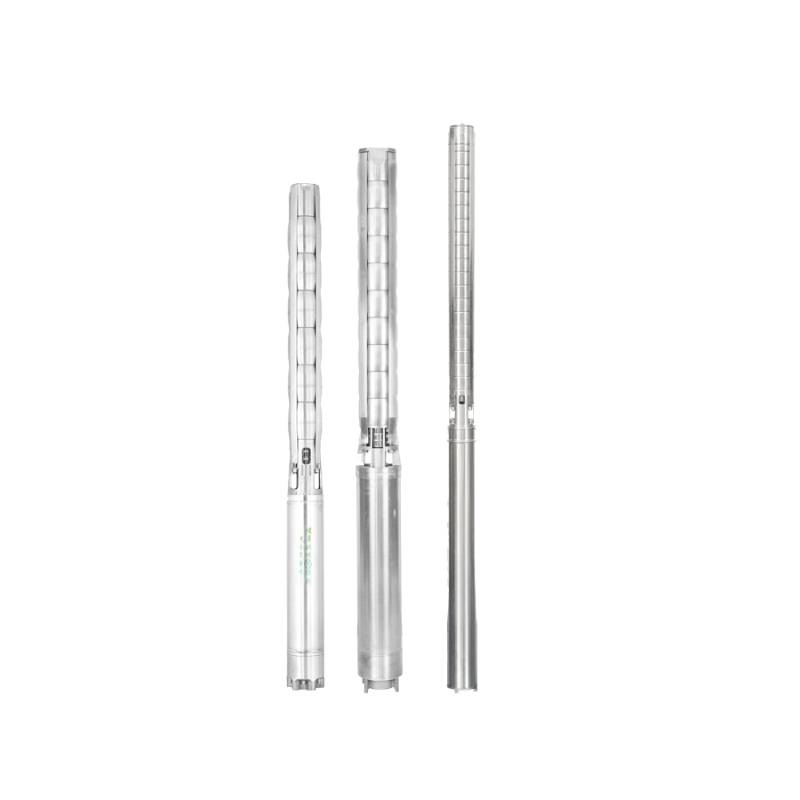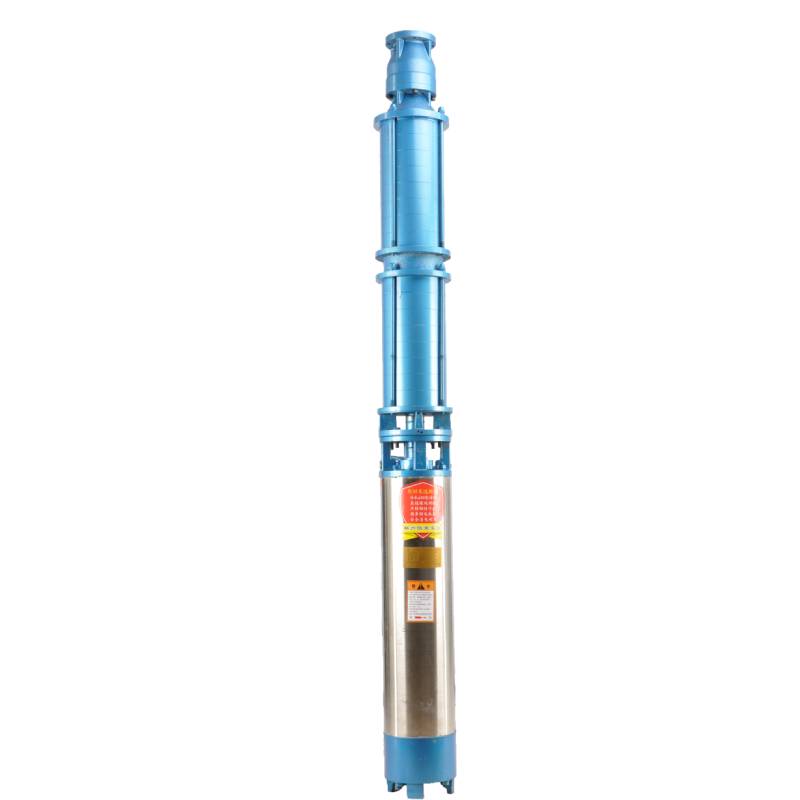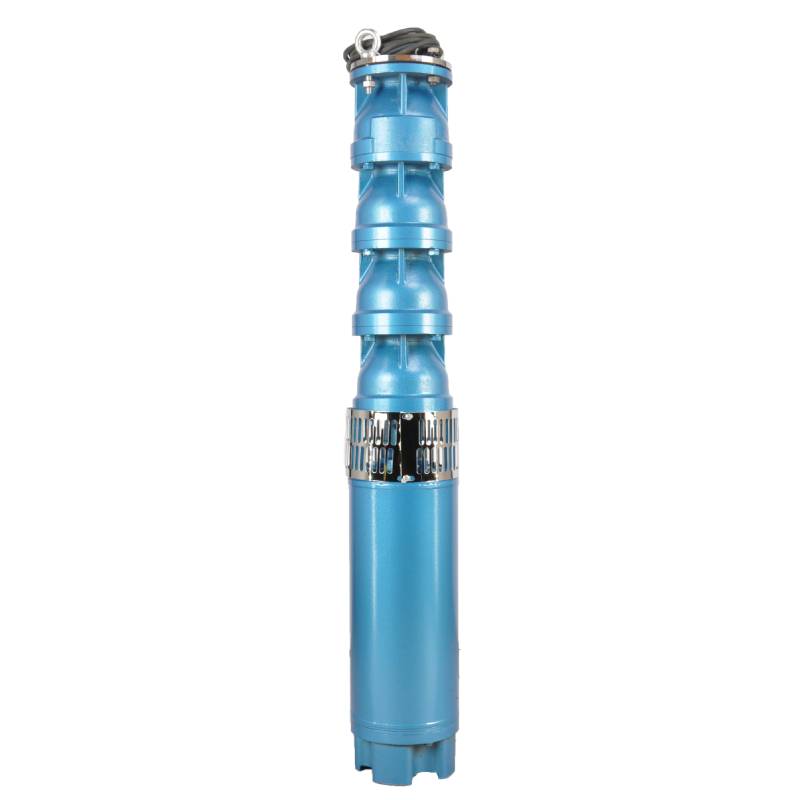QJP series fountain pump is a special pump for fountain developed by our factory.The pump motor core is made of high quality cold rolled silicon steel, which makes the pump more efficient, good magnetic conductivity, and frequent start will not fever.Both ends of the motor rotor use water as lubricant alloy copper sleeve.Stainless steel sleeve instead of ball bearings, to avoid the problem of easy rust ball bearings and lack of oil wear and tear the motor.The most suitable for music fountain use, all models can be used.
This product is a three-phase AC 380V (tolerance + / - 5%), 50HZ (tolerance + / - 1%) power supply system. Applicable water quality conditions include water temperature not exceeding 20 °C, solid impurities content (mass ratio) is not greater than 0.01%, PH value (pH) is 6.5-8.5, hydrogen sulfide content is not greater than 1.5mg/L, chloride ion content is not greater than 400mg/L. The motor is a closed or water-filled wet structure. Before use, it must be filled with clean water to prevent false filling, and then tighten the water injection and exhaust bolts, otherwise it is not allowed to use. The submersible pump must be completely immersed in water, and the penetration depth shall not exceed 70m. The distance between the submersible pump base and the bottom of the well shall not be less than 3m. The well flow shall be able to meet the water output and continuous operation of the submersible pump. The water output of the submersible pump shall be controlled at 0.7-1.2 times of the rated flow. The well shall be vertical, and the submersible pump can not be used horizontally or upside down, but only vertically. The submersible pump shall be equipped with cables and external overload protection devices as required. The pump is strictly prohibited from no-load test without water.
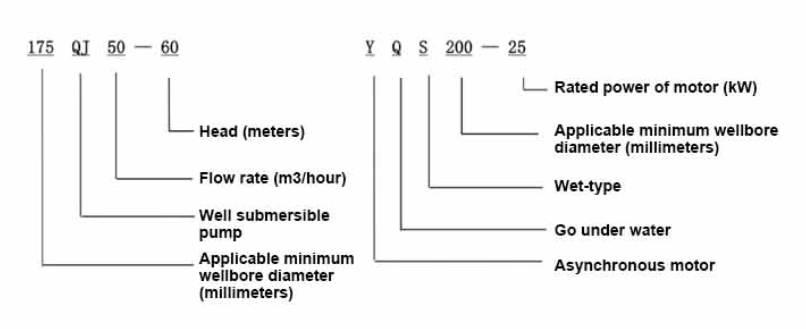
| Modail | Sruth (m3/h) | Ceann (m) |
Luas rothlach (atharrachadh/puing) |
Pumpa uisge (%) | Ar-a-mach trast-thomhas (mm) |
Gu math iomchaidh trast-thomhas (mm) |
Rangaichte power(KW) |
Rangaichte bholtaids (V) |
Rangaichte sruth (A) |
Èifeachdas motair (%) | power factorcosφ | Aonad Meud radial (mm) |
|||||||||
| 175QJ10-42 | 10 | 42 | 2850 | 53 | 50 | 175gu h-àrd | 3 | 380 | 7.8 | 74.0 | 0.79 | 168 | |||||||||
| 175QJ10-56 | 56 | 4 | 10.1 | 76.0 | 0.79 | ||||||||||||||||
| 175QJ10-70 | 70 | 4 | 10.1 | 76.0 | 0.79 | ||||||||||||||||
| 175QJ10-84 | 84 | 5.5 | 13.6 | 77.0 | 0.8 | ||||||||||||||||
| 175QJ10-112 | 112 | 7.5 | 18.4 | 77.5 | 0.8 | ||||||||||||||||
| 175QJ10-126 | 126 | 7.5 | 18.4 | 77.5 | 0.8 | ||||||||||||||||
| 175QJ10-140 | 140 | 9.2 | 22.1 | 78.0 | 0.81 | ||||||||||||||||
| 175QJ15-42 | 15 | 42 | 2850 | 58 | 50 | 175gu h-àrd | 4 | 380 | 10.1 | 76.0 | 0.79 | 168 | |||||||||
| 175QJ15-55 | 55 | 5.5 | 13.6 | 77.0 | 0.8 | ||||||||||||||||
| 175QJ15-65 | 65 | 5.5 | 13.6 | 77.0 | 0.8 | ||||||||||||||||
| 175QJ15-85 | 85 | 7.5 | 18.4 | 77.5 | 0.8 | ||||||||||||||||
| 175QJ15-112 | 112 | 9.2 | 22.1 | 78.0 | 0.81 | ||||||||||||||||
| 175QJ20-26 | 20 | 26 | 2850 | 64 | 50 | 175gu h-àrd | 3 | 380 | 7.8 | 74.0 | 0.79 | 168 | |||||||||
| 175QJ20-39 | 39 | 4 | 10.1 | 76.0 | 0.79 | ||||||||||||||||
| 175QJ20-52 | 52 | 5.5 | 13.6 | 77.0 | 0.8 | ||||||||||||||||
| 175QJ20-78 | 78 | 7.5 | 18.4 | 77.5 | 0.8 | ||||||||||||||||
| 175QJ20-91 | 91 | 9.2 | 22.1 | 78.0 | 0.81 | ||||||||||||||||
| 175QJ20-104 | 104 | 11 | 26.1 | 79.0 | 0.81 | ||||||||||||||||
| 175QJ20-130 | 130 | 13 | 30.1 | 80.0 | 0.82 | ||||||||||||||||
| 175QJ20-156 | 156 | 15 | 34.7 | 80.0 | 0.82 | ||||||||||||||||
| 175QJ20-182 | 187 | 18.5 | 42.6 | 80.5 | 0.82 | ||||||||||||||||
| 175QJ20-208 | 208 | 22 | 49.7 | 81.0 | 0.83 | ||||||||||||||||
| 175QJ20-247 | 247 | 25 | 56.5 | 81.0 | 0.83 | ||||||||||||||||
| 175QJ20-273 | 273 | 30 | 66.6 | 81.5 | 0.84 | ||||||||||||||||
| 175QJ20-299 | 299 | 30 | 66.6 | 81.5 | 0.84 | ||||||||||||||||
| 175QJ20-325 | 325 | 32 | 71.0 | 81.5 | 0.84 | ||||||||||||||||
| 175QJ20-364 | 364 | 37 | 82.1 | 81.5 | 0.84 | ||||||||||||||||
| 175QJ25-26 | 25 | 26 | 2850 | 66 | 65 | 175gu h-àrd | 3 | 380 | 7.8 | 74.0 | 0.79 | 168 | |||||||||
| 175QJ25-39 | 39 | 5.5 | 13.6 | 77.0 | 0.8 | ||||||||||||||||
| 175QJ25-65 | 25 | 65 | 2850 | 66 | 65 | 175gu h-àrd | 7.5 | 380 | 18.4 | 77.5 | 0.8 | 168 | |||||||||
| 175QJ25-78 | 78 | 9.2 | 22.1 | 78.0 | 0.81 | ||||||||||||||||
| 175QJ25-91 | 91 | 11 | 26.1 | 79.0 | 0.81 | ||||||||||||||||
| 175QJ25-104 | 104 | 13 | 30.1 | 80.0 | 0.82 | ||||||||||||||||
| 175QJ25-130 | 130 | 15 | 34.7 | 80.0 | 0.82 | ||||||||||||||||
| 175QJ25-156 | 156 | 18.5 | 42.6 | 80.5 | 0.82 | ||||||||||||||||
| 175QJ25-182 | 182 | 22 | 49.7 | 81.0 | 0.83 | ||||||||||||||||
| 175QJ25-208 | 208 | 25 | 56.5 | 81.0 | 0.83 | ||||||||||||||||
| 175QJ25-221 | 221 | 30 | 66.6 | 81.5 | 0.84 | ||||||||||||||||
| 175QJ25-247 | 247 | 30 | 66.6 | 81.5 | 0.84 | ||||||||||||||||
| 175QJ25-260 | 260 | 32 | 71.0 | 81.5 | 0.84 | ||||||||||||||||
| 175QJ25-299 | 299 | 37 | 82.1 | 81.5 | 0.84 | ||||||||||||||||
| 175QJ30-30 | 30 | 30 | 2850 | 67 | 80 | 175gu h-àrd | 4 | 380 | 10.1 | 76.0 | 0.79 | 168 | |||||||||
| 175QJ30-40 | 40 | 5.5 | 13.6 | 77.0 | 0.8 | ||||||||||||||||
| 175QJ32-24 | 32 | 24 | 2850 | 67 | 80 | 175gu h-àrd | 4 | 380 | 10.1 | 76.0 | 0.79 | 168 | |||||||||
| 175QJ32-36 | 36 | 5.5 | 13.6 | 77.0 | 0.8 | ||||||||||||||||
| 175QJ32-48 | 48 | 7.5 | 18.4 | 77.5 | 0.8 | ||||||||||||||||
| 175QJ32-60 | 60 | 9.2 | 22.1 | 78.0 | 0.81 | ||||||||||||||||
| 175QJ32-72 | 72 | 11 | 26.1 | 79.0 | 0.81 | ||||||||||||||||
| 175QJ32-84 | 84 | 13 | 30.1 | 80.0 | 0.82 | ||||||||||||||||
| 175QJ32-96 | 96 | 15 | 34.7 | 80.0 | 0.82 | ||||||||||||||||
| 175QJ32-120 | 120 | 18.5 | 42.6 | 80.5 | 0.82 | ||||||||||||||||
| 175QJ32-144 | 144 | 22 | 49.7 | 81.0 | 0.83 | ||||||||||||||||
| 175QJ32-168 | 168 | 25 | 56.5 | 81.0 | 0.83 | ||||||||||||||||
| 175QJ32-180 | 180 | 30 | 66.6 | 81.5 | 0.84 | ||||||||||||||||
| 175QJ32-192 | 192 | 30 | 66.6 | 81.5 | 0.84 | ||||||||||||||||
| 175QJ32-204 | 204 | 32 | 71.0 | 81.5 | 0.84 | ||||||||||||||||
| 175QJ32-240 | 240 | 37 | 82.1 | 81.5 | 0.84 | ||||||||||||||||
| 175QJ35-60 | 35 | 60 | 2850 | 67 | 80 | 175gu h-àrd | 10 | 380 | 25.0 | 78.0 | 0.78 | 168 | |||||||||
| 175QJ35-75 | 75 | 13 | 30.1 | 80.0 | 0.82 | ||||||||||||||||
| 175QJ35-100 | 100 | 17 | 40.9 | 80.0 | 0.79 | ||||||||||||||||
| 175QJ40-24 | 40 | 24 | 2850 | 70 | 80 | 175gu h-àrd | 5.5 | 380 | 13.6 | 77.0 | 0.8 | 168 | |||||||||
| 175QJ40-30 | 30 | 5.5 | 13.6 | 77.0 | 0.8 | ||||||||||||||||
| 175QJ40-36 | 36 | 7.5 | 18.4 | 77.5 | 0.8 | ||||||||||||||||
| 175QJ40-48 | 48 | 9.2 | 22.1 | 78.0 | 0.81 | ||||||||||||||||
| 175QJ40-60 | 60 | 11 | 26.1 | 79.0 | 0.81 | ||||||||||||||||
| 175QJ40-72 | 72 | 13 | 30.1 | 80.0 | 0.82 | ||||||||||||||||
| 175QJ40-84 | 84 | 15 | 34.7 | 80.0 | 0.82 | ||||||||||||||||
| 175QJ40-96 | 96 | 18.5 | 42.6 | 80.5 | 0.82 | ||||||||||||||||
| 175QJ40-120 | 120 | 22 | 49.7 | 81.0 | 0.83 | ||||||||||||||||
| 175QJ40-132 | 132 | 25 | 56.5 | 81.0 | 0.83 | ||||||||||||||||
| 175QJ40-144 | 144 | 30 | 66.6 | 81.5 | 0.84 | ||||||||||||||||
| 175QJ40-156 | 156 | 30 | 66.6 | 81.5 | 0.84 | ||||||||||||||||
| 175QJ40-168 | 168 | 32 | 71.0 | 81.5 | 0.84 | ||||||||||||||||
| 175QJ40-192 | 192 | 37 | 82.1 | 81.5 | 0.84 | ||||||||||||||||
| 175QJ50-24 | 50 | 24 | 2850 | 72 | 80 | 175gu h-àrd | 5.5 | 380 | 13.6 | 77.0 | 0.8 | 168 | |||||||||
| 175QJ50-36 | 36 | 9.2 | 22.1 | 78.0 | 0.81 | ||||||||||||||||
| 175QJ50-48 | 48 | 11 | 26.1 | 79.0 | 0.81 | ||||||||||||||||
| 175QJ50-60 | 60 | 13 | 30.1 | 80.0 | 0.82 | ||||||||||||||||
| 175QJ50-70 | 70 | 17 | 40.9 | 80.0 | 0.79 | ||||||||||||||||
| 175QJ50-84 | 84 | 18.5 | 42.6 | 80.5 | 0.82 | ||||||||||||||||
| 175QJ50-96 | 96 | 22 | 49.7 | 81.0 | 0.83 | ||||||||||||||||
| 175QJ50-108 | 108 | 25 | 56.5 | 81.0 | 0.83 | ||||||||||||||||
| 175QJ50-120 | 120 | 30 | 66.6 | 81.5 | 0.84 | ||||||||||||||||
| 175QJ50-132 | 132 | 30 | 66.6 | 81.5 | 0.84 | ||||||||||||||||
| 175QJ50-144 | 144 | 32 | 71.0 | 81.5 | 0.84 | ||||||||||||||||
| 175QJ50-156 | 156 | 37 | 82.1 | 81.5 | 0.84 | ||||||||||||||||
| 175QJ63-22 | 63 | 22 | 2850 | 72 | 80 | 175gu h-àrd | 7.5 | 380 | 18.4 | 77.5 | 0.8 | 168 | |||||||||
| 175QJ63-44 | 44 | 13 | 30.1 | 80.0 | 0.82 | ||||||||||||||||
| 175QJ63-55 | 55 | 15 | 34.7 | 80.0 | 0.82 | ||||||||||||||||
| 175QJ63-66 | 66 | 18.5 | 42.6 | 80.5 | 0.82 | ||||||||||||||||
| 175QJ63-77 | 77 | 22 | 49.7 | 81.0 | 0.83 | ||||||||||||||||
| 175QJ63-88 | 88 | 25 | 56.5 | 81.0 | 0.83 | ||||||||||||||||
| 175QJ63-99 | 63 | 99 | 2850 | 72 | 80 | 175gu h-àrd | 30 | 380 | 66.6 | 81.5 | 0.84 | 168 | |||||||||
| 175QJ63-110 | 110 | 32 | 71.0 | 81.5 | 0.84 | ||||||||||||||||
| 175QJ63-132 | 132 | 37 | 82.1 | 81.5 | 0.84 | ||||||||||||||||
| 175QJ80-9 | 80 | 9 | 2850 | 73 | 100 | 175gu h-àrd | 4 | 380 | 10.1 | 76.0 | 0.79 | 168 | |||||||||
| 175QJ80-18 | 18 | 7.5 | 18.4 | 77.5 | 0.8 | ||||||||||||||||
| 175QJ80-27 | 27 | 11 | 26.1 | 79.0 | 0.81 | ||||||||||||||||
| 175QJ80-36 | 36 | 15 | 34.7 | 80.0 | 0.82 | ||||||||||||||||
| 175QJ80-45 | 45 | 18.5 | 42.6 | 80.5 | 0.82 | ||||||||||||||||
| 175QJ80-54 | 54 | 22 | 49.7 | 81.0 | 0.83 | ||||||||||||||||
| 175QJ80-63 | 63 | 25 | 56.5 | 81.0 | 0.83 | ||||||||||||||||
| 175QJ80-72 | 72 | 25 | 56.5 | 81.0 | 0.83 | ||||||||||||||||
| 175QJ80-81 | 81 | 30 | 66.6 | 81.5 | 0.84 | ||||||||||||||||
| 175QJ80-90 | 90 | 32 | 71.0 | 81.5 | 0.84 | ||||||||||||||||
| 175QJ80-98 | 98 | 37 | 82.1 | 81.5 | 0.84 | ||||||||||||||||
1, well submersible pump for clean water pump, prohibit the new well, pumping sediment and muddy water,
2, well water pump voltage grade of 380/50HZ, the use of other voltage grades of submersible motors need to be customized. The underground cable must use waterproof cable, must be equipped with starting equipment, such as distribution box, start not ready should have commonly used motor comprehensive protection function, such as short circuit overload protection, phase protection, undervoltage protection, grounding protection, idling protection, in case of abnormal conditions, the protection device should be timely action trip.
3, the installation and use of the pump must be reliably grounded, prohibit the push and pull switch when the hands and feet are wet, the installation and maintenance of the pump must be cut off the power supply, the use of the pump place to set up "to prevent electric shock" obvious signs:
4, down the well or before installation, the motor cavity must be filled with distilled water or non-corrosive clean cold boiling water, tighten the / water bolt, the pump on the ground test run, must be to the pump chamber water lubrication rubber bearings, instant start not more than a second, see whether the steering is the same as the steering instructions. When the pump is upright, pay attention to safety, prevent overturning injury.
5, gu teann a rèir ullachaidhean an lioft pumpaidh, raon cleachdaidh sruthadh, gus casg a chuir air sruthadh ìosal no feachd pumpaidh àrdachaidh, giùlan smeòrach agus pàirtean eile den chaitheamh, loisg an cus motair
6, after the pump down the well, the measurement of the motor to the ground insulation resistance should not be less than 100M, after the start to observe the voltage and current, check the motor winding insulation, whether in line with the requirements; pump storage location temperature if less than freezing point, should be dry the motor cavity water, prevent the motor cavity water ice damage caused by low temperature.
The pump part is mainly composed of pump shaft, impeller, shunt shell, rubber bearing, check valve body (optional) and other components. The motor part mainly includes base, pressure regulating diaphragm, thrust bearing, thrust plate, lower guide bearing seat, stator, rotor, upper guide bearing seat, sand ring, water inlet section, lead cable and other components. The main features of the product include: the motor is a water immersed wet three-phase asynchronous motor, the motor cavity is full of water, used to cool the motor and lubricate the bearing; the pressure regulating film at the bottom of the motor is used to adjust the expansion and contraction pressure difference of the internal water caused by the change of temperature; in order to prevent the sand particles in the well water from entering the motor, two oil seals are installed on the upper end of the motor shaft extension, and a sand control structure is formed by installing the sand ring; in order to prevent the pump shaft from jumping at startup, the pump shaft is connected with the motor shaft through a coupling, and the thrust bearing is installed under the motor; the lubrication of the motor and the pump bearing is water lubrication; the stator winding of the motor is made of high quality submersible motor winding, with high insulation performance; the pump is designed by computer CAD, with simple structure and excellent technical performance.

(1) Ag ullachadh mus stàladh:
1. Dèan cinnteach a bheil am pumpa fon uisge a’ coinneachadh ris na cumhaichean cleachdaidh agus an raon a tha air a shònrachadh san leabhar-làimhe.
2. A’ cleachdadh inneal trom le trast-thomhas co-ionann ris an trast-thomhas a-muigh as àirde den phump a tha fon uisge, tomhais an urrainn dha trast-thomhas a-staigh an tobair a bhith a’ freagairt air a’ phumpa fon uisge, agus tomhas a bheil doimhneachd an tobair a’ coinneachadh ri riatanasan an stàlaidh.
3. Dèan cinnteach a bheil toll an tobair glan agus a bheil uisge an tobair turbid. Na cleachd pumpa dealain fon uisge gu bràth gus poll pumpa welor agus uisge gainmhich a nighe gus milleadh ro-luath air a’ phump dealain fon uisge a sheachnadh.
4. Dèan cinnteach a bheil suidheachadh a’ chlamp stàlaidh welhead freagarrach agus an urrainn dha seasamh ri càileachd an aonaid gu lèir
5. Dèan cinnteach a bheil na pàirtean pumpa fon uisge coileanta agus air an stàladh ceart a rèir an diagram cruinneachaidh san leabhar-làimhe Thoir air falbh an scrion sìoltachain agus cuairteachadh a’ chàraid gus faicinn a bheil e a ’tionndadh gu sùbailte
6. Unscrew an sgriubha uisge agus lìon a’ chuas motair le uisge glan, neo-chreimneach (nota. bi cinnteach gun cuir thu a-steach e), agus an uairsin teannachadh an sgriubha uisge. Às deidh 12 uair de in-stealladh uisge, cha bu chòir an aghaidh insulation an motair a bhith nas ìsle na 150M Q nuair a thèid a thomhas le clàr crathadh 500V.
7. Cable joint, cut off a 120mm rubber sleeve from one end of the outgoing cable and the matching cable with an electrician's knifethen stagger the length of the three core wires in a stepped shape, peel off a 20mm copper core, scrape of the oxide layer on theoutside of the copper wire with a knife or sand cloth, and insert the two connected wire ends in palirs.After tying the layer tightly with fine copper wire, solder it thoroughly and firmly, and sand of any. burrs on the surface. Then, forthe three joints, use polyvester insulation tape to wrap them in a semi stacked manner for three lavers. Wrap the two ends of thewrapping layer tightywith nyion thread,and then use a semi stacked method to wrap the tape for three layers. Wrap the outellayer with high-pressure insulation tape for three layers. Finally, fold the threestrands together and repeatedly wrap them for fivelayers with high-pressure tape. Each layer must be tightly tied, and the interlayer joints must be tight and fimm to prevent water frompenetrating and damaging the insulation, After wrapping, soak in water at room temperature of 20 ’c for 12 hours, and measurethe insulation resistance with a shaking table, which should not be less than 100M Ω
Tha an diagram pròiseas sreangadh càball ceangailte mar a leanas: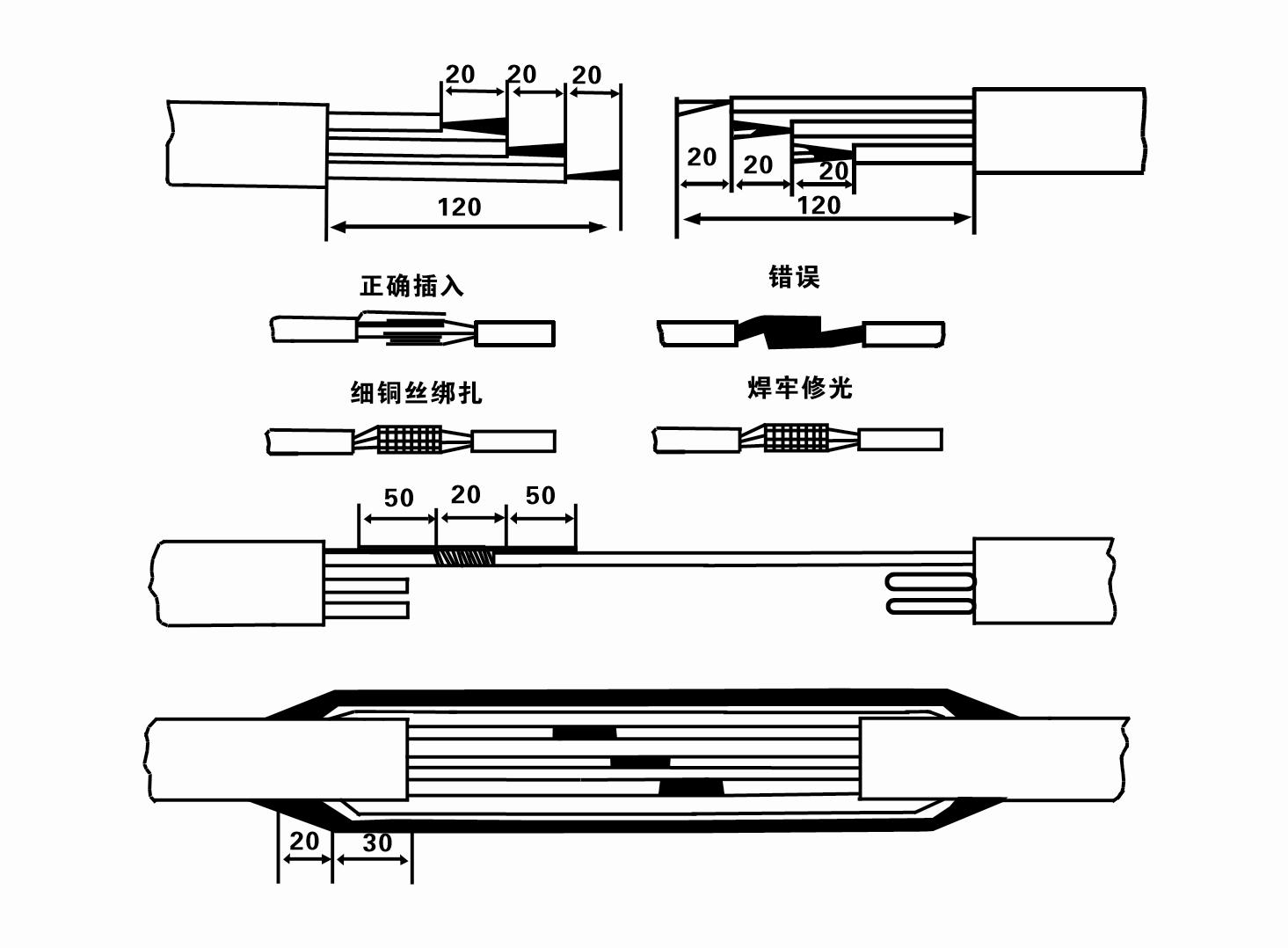
8. Cleachd multimeter gus dèanamh cinnteach a bheil na h-uèirichean trì-ìrean ceangailte agus a bheil an aghaidh DC timcheall air cothromach.
9. Dèan cinnteach a bheil cus luchd air a’ chuairt agus comas an cruth-atharrachaidh, agus an uairsin ceangail an tionndadh dìon cus cuideim no an uidheamachd tòiseachaidh. Faic Clàr 2 airson modalan sònraichte, agus an uairsin dòirt bucaid uisge a-steach don phump uisge bhon ionad pumpa uisge gus na giùlan rubair a lubricadh anns a’ phump, agus an uairsin cuir am pumpa dealain fon uisge gu dìreach agus gu seasmhach.Start (gun a bhith nas fhaide na aon diog). agus dèan cinnteach a bheil an stiùireadh stiùiridh co-chòrdail ris an t-soidhne stiùiridh. Mura h-eil, suaip dà cheangail den chàball trì-ìre.Then stàlaich an criathrag agus ullaich airson a dhol sìos an tobar. Ma thèid a chleachdadh aig amannan sònraichte (leithid dìgean, dìgean, aibhnichean, lochan, lòin, msaa), feumaidh am pumpa dealain a bhith air a chuir air bhonn gu h-earbsach.
(2) Uidheam agus innealan stàlaidh:
1. Aon phaidhir de shlabhraidhean togail airson barrachd air dà thunna.
2. Tripod le àirde dìreach nach eil nas lugha na ceithir meatairean.
3. Dà ròp crochte (ròpaichean uèir) as urrainn cuideam nas motha na aon tunna a ghiùlan (faodaidh cuideam seata iomlan de phumpaichean uisge a ghiùlan).
4. Stàlaich dà phaidhir de clamps (splints).
5. Wrenches, ùird, screwdrivers, innealan dealain agus ionnstramaidean, msaa.
(3) Stàladh pumpa dealain:
1. Tha an diagram stàlaidh den phump dealain submersible air a shealltainn ann am Figear 2. Tha na tomhasan stàlaidh sònraichte air an sealltainn ann an Clàr 3 "Liosta de mheudan stàlaidh a' phump dealain fon uisge".
2. Faodar pumpaichean dealain fon uisge le ceann nas lugha na 30 meatair a thogail gu dìreach a-steach don tobar le bhith a’ cleachdadh phìoban agus ròpaichean uèir no ròpannan hemp eile as urrainn làn chuideam an inneil gu lèir, pìoban uisge, agus uisge anns na pìoban a ghiùlan.
3. Bidh pumpaichean le ceann nas motha na 30 meatair a 'cleachdadh pìoban stàilinn, agus tha an sreath stàlaidh mar a leanas:
① Cleachd clamp gus ceann shuas pàirt a’ phump uisge a chlampadh (tha am pumpa motair is uisge air a cheangal aig an àm seo), tog e le slabhraidh crochte, agus ceangail gu slaodach a-steach don tobar gus an cuir thu an clamp air ceann an tobair agus thoir air falbh an slabhraidh crochte.
② Cleachd paidhir clamps eile gus pìob a chlampadh, tog e le slabhraidh crochte 15 cm air falbh bhon flange, agus lughdaich e gu slaodach. Eadar flange pìoba agus flange pumpa Cuir am pasgan rubair na àite agus teannachadh a’ phìob agus am pumpa gu cothromach le boltaichean, cnothan agus nigheadairean earraich.
③ Tog beagan am pumpa fon uisge, thoir air falbh an clamp air ceann shuas a’ phump uisge, ceangail an càball gu daingeann ris a’ phìob uisge le teip plastaig, agus ceangail sìos e gu slaodach gus an tèid an clamp a chuir aig ceann an tobair.
④ Cleachd an aon dòigh airson a h-uile pìob uisge a cheangal a-steach don tobar.
⑤ Às deidh don chàball luaidhe a bhith ceangailte ris an suidse smachd, tha e ceangailte ris an t-solar cumhachd trì ìrean.
(4) Rudan ri thoirt fa-near aig àm an stàlaidh:
1. Ma lorgar iongantas jamming tron phròiseas pumpaidh, tionndaidh no tarraing am pìob uisge gus faighinn thairis air a’ phuing jamming. Mura h-eil grunn cheumannan ag obair fhathast, feuch nach toir thu air a’ phump sìos gus milleadh a sheachnadh air a’ phump dealain fon uisge agus an tobar.
2. Rè an stàladh, bu chòir ceap rubair a chuir aig flange gach pìoba agus a theannachadh gu cothromach.
3. Nuair a thèid am pumpa uisge a leigeil a-steach don tobar, bu chòir a chuir ann am meadhan pìob an tobair gus casg a chuir air a ’phump bho bhith a’ ruith an-aghaidh balla an tobair airson ùine mhòr, ag adhbhrachadh gum bi am pumpa a ’crith agus an motair a’ sguabadh agus a losgadh .
4. Obraich a-mach doimhneachd a' phump uisge gu bonn an tobair a rèir suidheachadh gainmhich is eabar an tobair. Na cuir a-steach am pumpa san eabar. Mar as trice chan eil an astar bhon phump uisge gu bonn an tobair nas lugha na 3 meatairean (faic Figear 2).
5. Cha bu chòir doimhneachd inntrigidh uisge a’ phump uisge a bhith nas lugha na 1-1.5 meatairean bhon ìre uisge fiùghantach chun nód uisge a-steach (faic Figear 2). Rud eile, dh ’fhaodadh na giùlan pumpa uisge a bhith air am milleadh gu furasta.
6. Chan urrainn togail a' phump uisge a bhith ro ìosal. Rud eile, feumar bhalbhaichean geata a chuir a-steach air loidhne-phìoban uisge ceann an tobair gus smachd a chumail air sruthadh a’ phump aig a’ phuing sruthadh ìre gus casg a chuir air a’ motair a bhith air a luchdachadh cus agus a losgadh a-mach air sgàth ìrean sruth mòr.
7. Nuair a bhios am pumpa uisge a 'ruith, bu chòir an toradh uisge a bhith leantainneach agus eadhon, bu chòir an sruth a bhith seasmhach (fo chumhachan obrach comharraichte, mar as trice gun a bhith nas fhaide na 10% den t-sruth), agus cha bu chòir crith no fuaim a bhith ann. Ma tha ana-cainnt sam bith ann, bu chòir stad a chuir air an inneal gus faighinn a-mach an adhbhar agus cuir às dha.
8. Nuair a bhios tu a’ stàladh, thoir aire do shuidheachadh an uèir talmhainn motair (faic Figear 2). Nuair a tha am pìob uisge na phìob stàilinn, stiùir e bhon chlamp ceann tobair; nuair a tha am pìob uisge na phìob plastaig, stiùir e bho chomharra bunaiteach a’ phump dealain.
- 1.After installing the submersible pump, recheck the insulation resistance and the three-phase continuity at the switch, and check whether there are errors in the connection of the instrument and the starting equipment.If there are no problems, you can start to test the machine. After starting, observe whether the indication readings of each instrument are correct. If the rated voltage and current specified on the nameplate are exceeded, observe whether the pump emits any noise or vibration. If everything is normal, it can be put into operation.
- 2. After the pump runs for the first four hours, the thermal insulation resistance of the motor should be closed and tested quickly.Its value should not be less than 0.5 megaohm.After the pump stops, it should be restarted after an interval of five minutes to prevent the water column in the pipeline from completely reversing and burning the motor due to excessive current.
- 3. After the pump is put into normal operation, in order to prolong its service life, it is necessary to check regularly whether the supply voltage, working current and insulation resistance are normal. If the following conditions are found, the machine should be stopped immediately to troubleshoot.
- 1 Anns an t-suidheachadh obrach le inbhe, tha an sruth nas àirde na 20%.
- 2 Bidh an ìre uisge fiùghantach a’ tuiteam chun roinn uisge a-steach, ag adhbhrachadh uisge eadar-amail.
- 3 Tha fìor chrith no fuaim aig a’ phump a tha fon uisge.
- 4 Tha an bholtadh solair nas ìsle na 340 volts.
- 5 Tha fiùs air a losgadh a mach.
- 6 Tha am pìob solarachaidh uisge air a mhilleadh.
- 7 Tha dìon insulation an motair an aghaidh staid geo-riaghailteach nas ìsle na 0.5 megaohm.
- Unit disassembly:
- 1.untie cable rope, remove the pipeline part, remove the wire plate.
- 2.screw down the water bolt, put the water in the motor chamber.
- 3.remove the filter, loose the fixed screw on the coupling to fix the motor shaft.
- 4.screw down the bolt connecting the inlet junction with the motor, and separate the pump from the motor (pay attention to the unit cushion when separating, to prevent the bending of the pump shaft)
- 5.the disassembly sequence of the pump is: (see figure 1) inlet junction, impeller, diversion shell, impeller...... check valve body, when removing the impeller, use special tools to loosen the conical sleeve of the fixed impeller first, and avoid bending and bruising of the pump shaft in the process of disassembly.
- 6.the disassembly process of the motor is: (see figure 1) place the motor on the platform, and remove the nuts, base, shaft head locking nut, thrust plate, key, lower guide bearing seat and double head bolt from the bottom of the motor in turn, and then take out the rotor (pay attention not to damage the wire package) and finally remove the connecting section and upper guide bearing seat.
- 7.unit assembly: before assembly, the rust and dirt of the parts should be cleaned, and the mating surface and fasteners coated with sealant, and then assembled in the reverse order of disassembly (the motor shaft moves up and down after assembly for about one millimeter), after assembly, the coupling should be flexible, and then the filter screen test machine. Submersible pumps shall be taken out of the well for dismantling and maintenance according to Article 5 after a year of operation, or less than a year of operation but two years of diving time, and the worn parts shall be replaced.
This product adopts advanced design and provides advanced storage suggestions to ensure long-term use effect.First of all, in winter, it is necessary to exhaust all the water to prevent freezing. In addition, the wire rolls should be placed well and tied up.Secondly, when storing, the environment without corrosive action and gas should be selected and the temperature should be kept below 40 °C. Finally, when not used for a long time, attention should be paid to prevent rust of submersible pump.These storage requirements will ensure that the product can maintain its performance status and prolong its service life for a long time.
- Impeller
- Muinchille shaft
- Muinchill rubair
-
Cearcall ròin
01 Tobar uisge domhainn
02 Solar uisge àrd
03 solar uisge beinne
04 tùr uisge
05 Uisgeachadh àiteachais
06 uisgeachadh gàrraidh
07 toirt a-steach uisge aibhne
08 uisge dachaigheil

